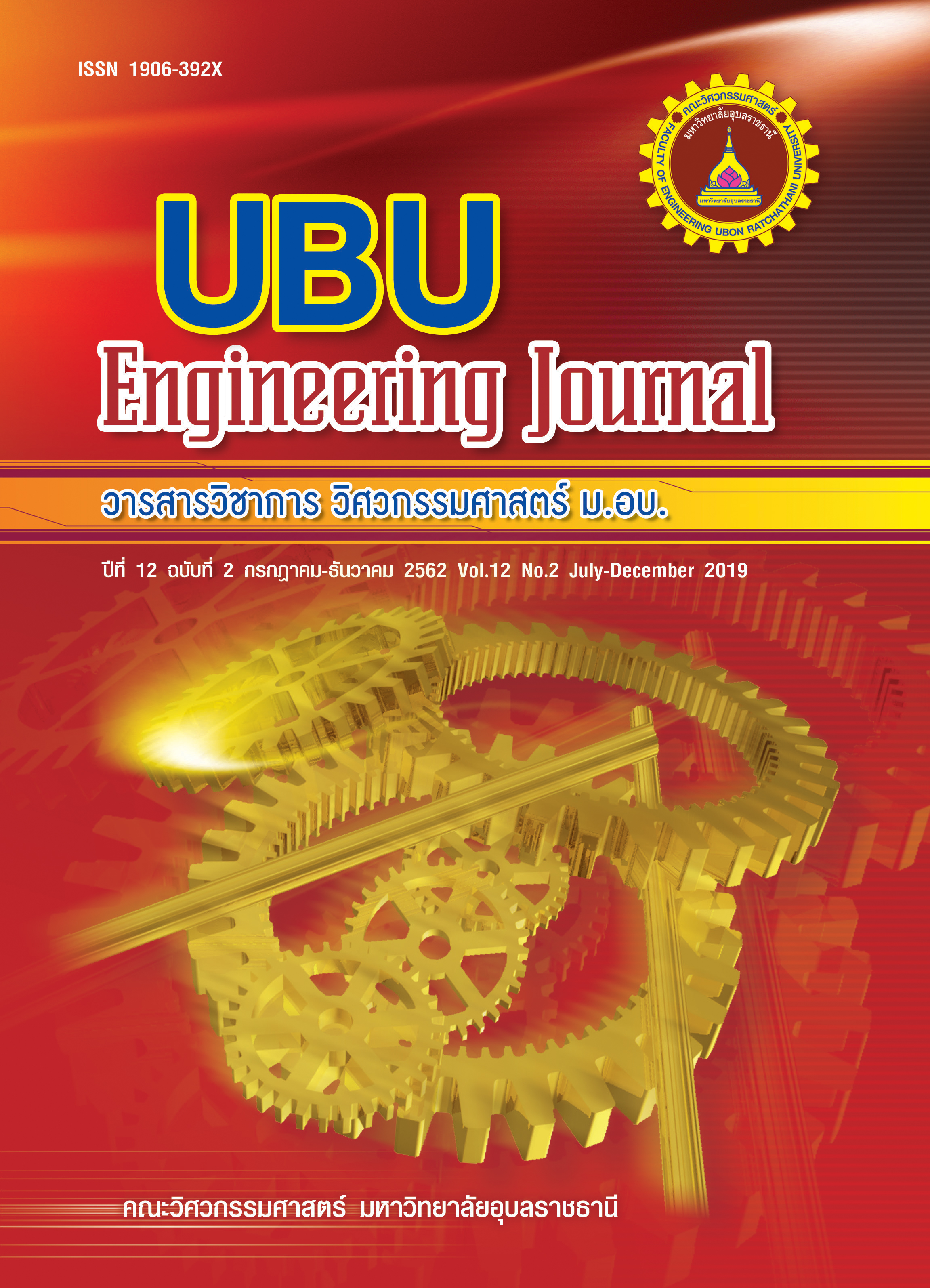Adsorption of Reactive Red 120 onto Cationic Surfactant intercalated Montmorillonite clay
Main Article Content
Abstract
In this work, cationic surfactant intercalated-montmorillonite (OMt) was prepared as adsorbent used for the removal of Reactive Red 120 (RR120) from aqueous solutions. The OMt and as received motmorillonite (Mt) were characterized by the FTIR, BET method, SEM, and XRD. The affecting factors such as contact time, initial dye concentration, initial pH, and temperature were investigated. The result revealed that adsorption of RR120 reached equilibrium at 480 minutes. The uptake of RR120 increased with temperatures, indicating an endothermic process. The adsorption capacity was slightly decreased with increasing in pH. Kinetics data were well described by the pseudo-second order model. The equilibrium data were better fitted by the Langmuir isotherm and the maximum monolayer adsorption capacity was 268.54 mg. g-1. These results suggested that the OMt is an effective adsorbent for removing RR120 from aqueous solutions.
Keywords: Adsorption, Reactive red 120, Cationic surfactant, Montmorillonite clay
Article Details
References
[2] O'Neill, C., Lopez, A., Esteves, S., Hawkes, F.R., Hawkes, D.L. and Wilcox, S. 2000. Azo-dye degradation in an anaerobic-aerobic treatment system operating on simulated textile effluent. Appl. Microbiol. Biotechnol., 53(2): 249-254.
[3] Umpuch, C., Jutarat, B. 2012. Adsorption behavior of reactive black 5 dye on activated carbon prepared from sugarcane bagasse. UBU Eng. J., 5(2): 10-21.
[4] Umpuch, C. 2012. Modification of montmorillonite clay for dye removal from wastewater: a review, UBU Eng. J., 5(1): 56-66.
[5] Monvisade, P. and Siriphannon, P. 2009. Chitosan intercalated montmorillonite: Preparation, characterization and cationic dye adsorption. Appl. Clay Sci., 42 (3-4): 427-431.
[6] Zhang, R. Yan, W. and C. Jing. 2014. Mechanistic study of PFOS adsorption on kaolinite and montmorillonite, Colloids and Surf. A., 462: 252-258.
[7] Bhattacharyya, R. and Ray, S.K. 2015. Removal of congo red and methyl violet from water using nano clay filled composite hydrogels of poly acrylic acid and polyethylene glycol. Chem. Eng. J., 260: 269-283.
[8] Zhu, L. and Ma, J. 2008. Simultaneous removal of acid dye and cationic surfactant from water by bentonite in one-step process. Chem. Eng. J., 139(3): 503-509.
[9] Meira, S.M.M., Jardim, A.I., Brandelli, A. 2015. Adsorption of nisin and pediocin on nanoclays. Food Chemistry, 188: 161-169.
[10] Rytwo, G., Gonen, Y., Afuta, S. and Dultz, S. 2015. Interactions of pendimethalin with organo-montmorillonite complexes. Appl. Clay Sci., 28(1–4): 67-77.
[11] Anjaneyulu, U., Swaroop, V. and Vijayalakshmi, U. 2016. Preparation and characterization of novel Ag doped hydroxyapatite–Fe3O4–chitosan hybrid composites and in vitro biological evaluations for orthopaedic applications. RSC Advances. 6(13): 10997-11007.
[12] Wang, C.-C., Juang, L.C, Hsu, T.C., Lee, C. K., Lee, L.F., and Huang, F.C. 2004. Adsorption of basic dyes onto montmorillonite. J. Colloid Interface Sci., 273(1): 80-86.
[13] Myshakin, E. M., Wissam, A.S., Vyacheslav, N.R., Randall, T.C. and Kenneth, D. 2013. Molecular dynamics simulations of carbon dioxide intercalation in hydrated Na-montmorillonite. J. Phys. Chem. C, 117(21): 11028-11039.
[14] Zhou, Q., Frost, R.L., He, H. and Xi, Y. 2007. TEM, XRD, and thermal stability of adsorbed paranitrophenol on DDOAB organoclay, J. Colloid Interface Sci., 311(1): 24-37.
[15] Lorenc-Grabowska, E. and Gryglewicz, G. (2007). Adsorption characteristics of Congo Red on coal-based mesoporous activated carbon. Dyes Pigm., 7(1): 34-40.
[16] Mittal, H., Ballav, N. Mishra, S. 2014. Gum Ghatti and Fe3O4 magnetic nanoparticles based nanocomposites for the effective adsorption of methylene blue from aqueous solution. J. Ind. Eng. Chem., 20: 2184-2192.
[17] da Silva, J.S., Junqueira, H.C. and Ferreira, T.L. 2014. Effect of pH and dye concentration on the n-octanol/water distribution ratio of phenothiazine dyes: a microelectrode voltammetry study, Electrochim. Acta, 144: 154-160.
[18] Langmuir, I. 1918. The adsorption of gases on plane surfaces of glass, mica and platinum. J. Am. Chem. Soc., 40(9): 1361-1403.
[19] Umpuch, C. and Sakaew, S. 2013. Removal of methyl orange from aqueous solutions by adsorption using chitosan intercalated montmorillonite, Songklanakarin J. Sci. Technol., 35(4): 451-459.
[20] Yuh-Shan, H. 2004. Citation review of Lagergren kinetic rate equation on adsorption reactions. Scientometrics, 59(1): 171-177.
[21] Ho, Y. and McKay, G. 1998. The kinetics of sorption of basic dyes from aqueous solution by sphagnum moss peat. Can. J. Chem. Eng., 76(4): 822-827.
[22] Kobiraj, R.N., Gupta, A.K., Kushwaha, A.K. and Chattopadhyaya, M.C. 2012. Determination of equilibrium, kinetic and thermodynamic parameters for the adsorption of Brilliant Green dye from aqueous solutions onto eggshell powder. Indian J. Chem. Technol. 19: 26-31.
[23] Lyubchik, S., Perepichka, I., Galushko, O., Lyubchik, A., Lygina, E. and Fonseca, I. 2005. Optimization of the conditions for the Cr(III) adsorption on activated carbon. Adsorption, 11(5-6): 581-593.
[24] Maszkowska, J., Wagil, M., Mioduszewska, K., Kumirska, J., Stepnowski, P. and Biatk-Bielińska, A. 2014. Thermodynamic studies for adsorption of ionizable pharmaceuticals onto soil. Chemosphere, 111: 568-574.

